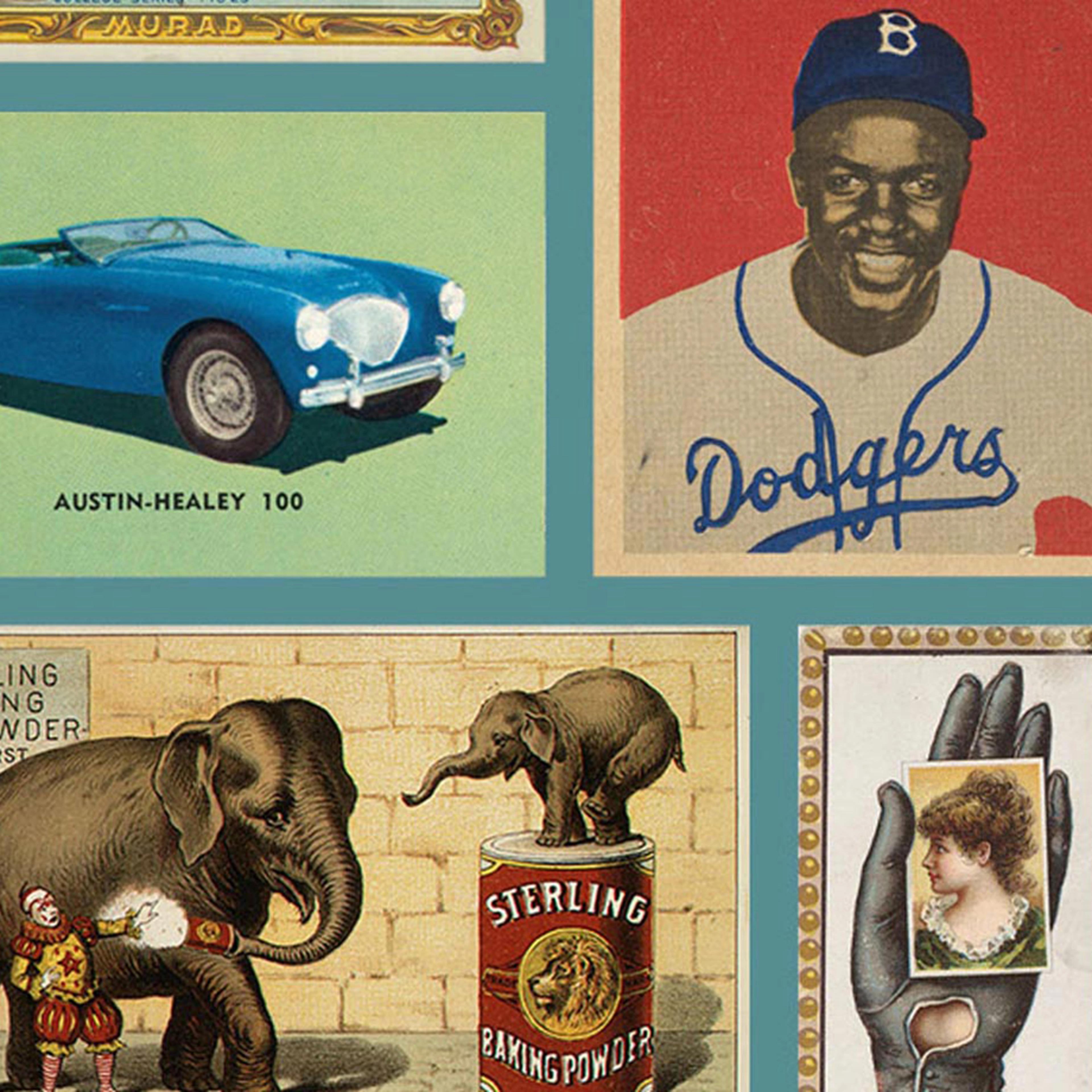In 1947, after having reached an agreement with A. Hyatt Mayor, curator of prints and photographs, Syracuse electrician Jefferson R. Burdick (1900–1963) began to donate his entire collection of approximately 303,000 advertising inserts, postcards, and posters in large batches to The Metropolitan Museum of Art. The Jefferson R. Burdick Collection constitutes a primary part of the Museum’s collection of ephemera, and helps tell the history of popular printmaking in the United States.
Collected by Burdick from the age of ten, the cards date from the 1860s to 1963. Dissatisfied with the initial organization and storage system of the enormous gift, Mayor had Burdick install his little Art Nouveau oak desk from home in the only available corner of the department and compile the collection himself into albums. Burdick spent the next fifteen years in the Museum creating a structure for various types of contemporary advertising material. In organizing the albums Burdick adhered to a strict cataloguing system that he devised and published as the American Card Catalog (first edition 1939, with revised editions appearing through 1960). Burdick’s method remains the standard system used by all collectors of early American printed ephemera.
In 1960 Burdick wrote that a card collection is “a magic carpet that takes you away from work-a-day cares to havens of relaxing quietude where you can relive the pleasures and adventures of a past day—brought to life in vivid picture and prose.” Burdick’s collection fulfills the mission set out by the founding curator of the Prints department, William Ivins, who understood that a truly encyclopedic collection throws open the gamut of human life and endeavor, and should be like the library of a professor of great literature: composed of a corpus of works in themselves distinctly works of art and filled out and illustrated by many other objects that have only technical, historical, social, or religious importance.
The four themes below present a selection of the ephemera in Burdick’s collection.
Baseball at The Met
The 1937 baseball season is now in full swing and the nation’s fans are daily cheering their favorite diamond stars. Baseball’s heroes come and go, but few people have a better record of the game’s great ones than the card collector…For Ruth and Gehrig and other present-day celebrities we must turn to the various candy and gum cards issued during the past few years. While intended primarily for the younger fans, they are of equal interest to all who love our national game.
—Jefferson R. Burdick
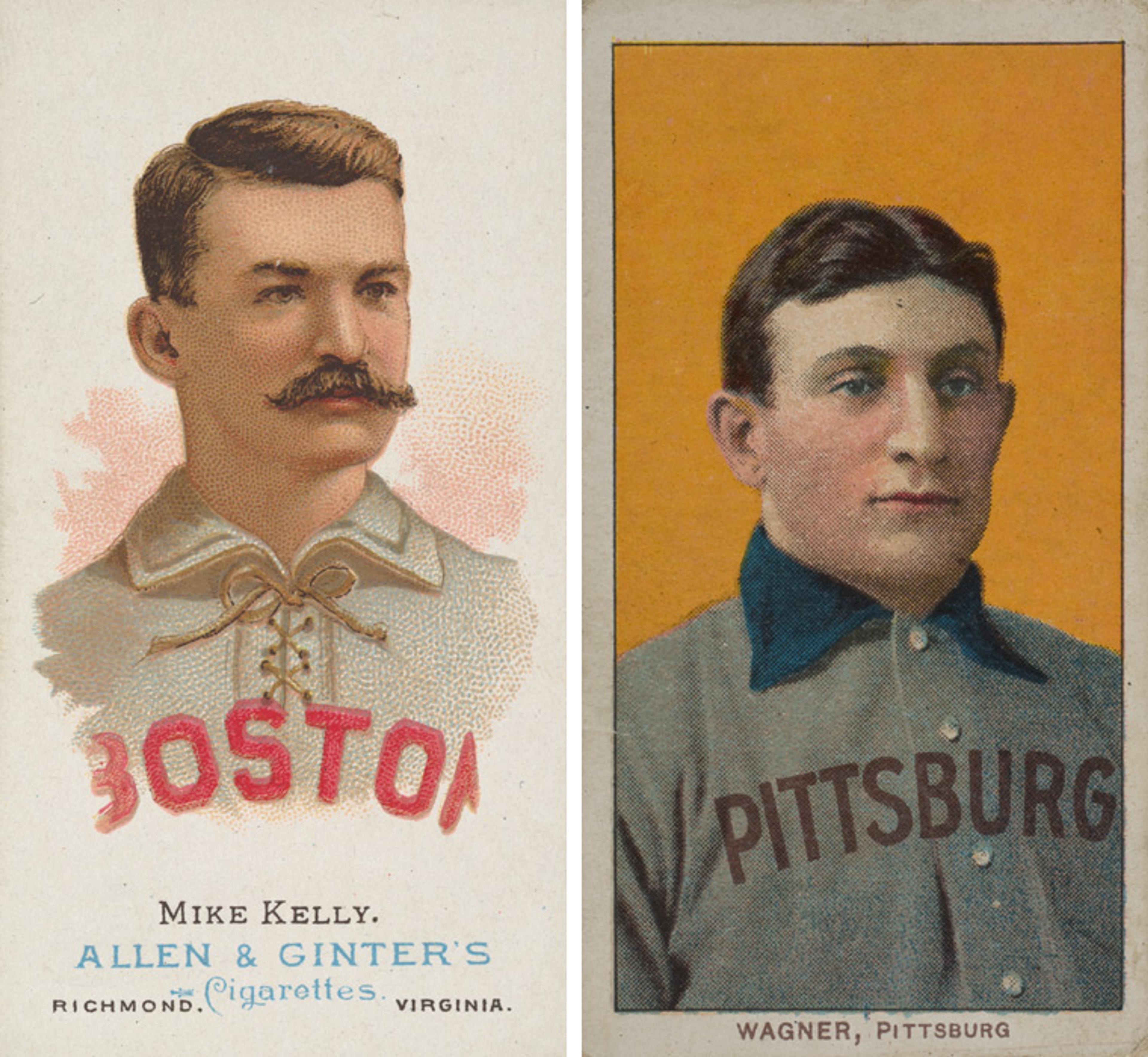
Left: Allen & Ginter (American, Richmond, Virginia). Mike "King" Kelly, Baseball Player, from World's Champions, Series 1 (N28) for Allen & Ginter Cigarettes, 1887. Commercial color lithograph; Sheet: 2 3/4 x 1 1/2 in. (7 x 3.8 cm). The Metropolitan Museum of Art, New York, The Jefferson R. Burdick Collection, Gift of Jefferson R. Burdick (63.350.201.28.3). Right: Issued by American Tobacco Company. Honus Wagner, Pittsburgh, National League, from the White Border series (T206) for the American Tobacco Company, 1909–11. Commercial lithograph; Sheet: 2 5/8 x 1 1/2 in. (6.7 x 3.7 cm). The Metropolitan Museum of Art, New York, The Jefferson R. Burdick Collection, Gift of Jefferson R. Burdick (63.350.246.206.378)
The more than thirty thousand baseball cards collected by Jefferson R. Burdick represent the most comprehensive collection outside of the Baseball Hall of Fame in Cooperstown, New York. The cards also illustrate the history of the game—from the dead-ball era at the turn of the nineteenth century to the golden age and modern era of the sport. Baseball cards were first used as advertising inserts by tobacco companies beginning in the late 1800s. Burdick's earliest cards were incorporated into a series called Champions of the World, produced by Allen & Ginter Tobacco. These illustrate players like Mike “King” Kelley, “Cap” Anson, and Charles Comiskey. The most magnificent card in the collection is the rare and pristine 1910 Honus Wagner card from the White Border series. Only fifty-seven copies of this card are known to exist because Wagner is believed to have pulled them from the tobacco products, unhappy that they would entice boys to buy the product. Wagner’s act may have instigated the shift from the advertising of baseball primarily in tobacco to including the inserts within more youth-friendly gum and candy goods.
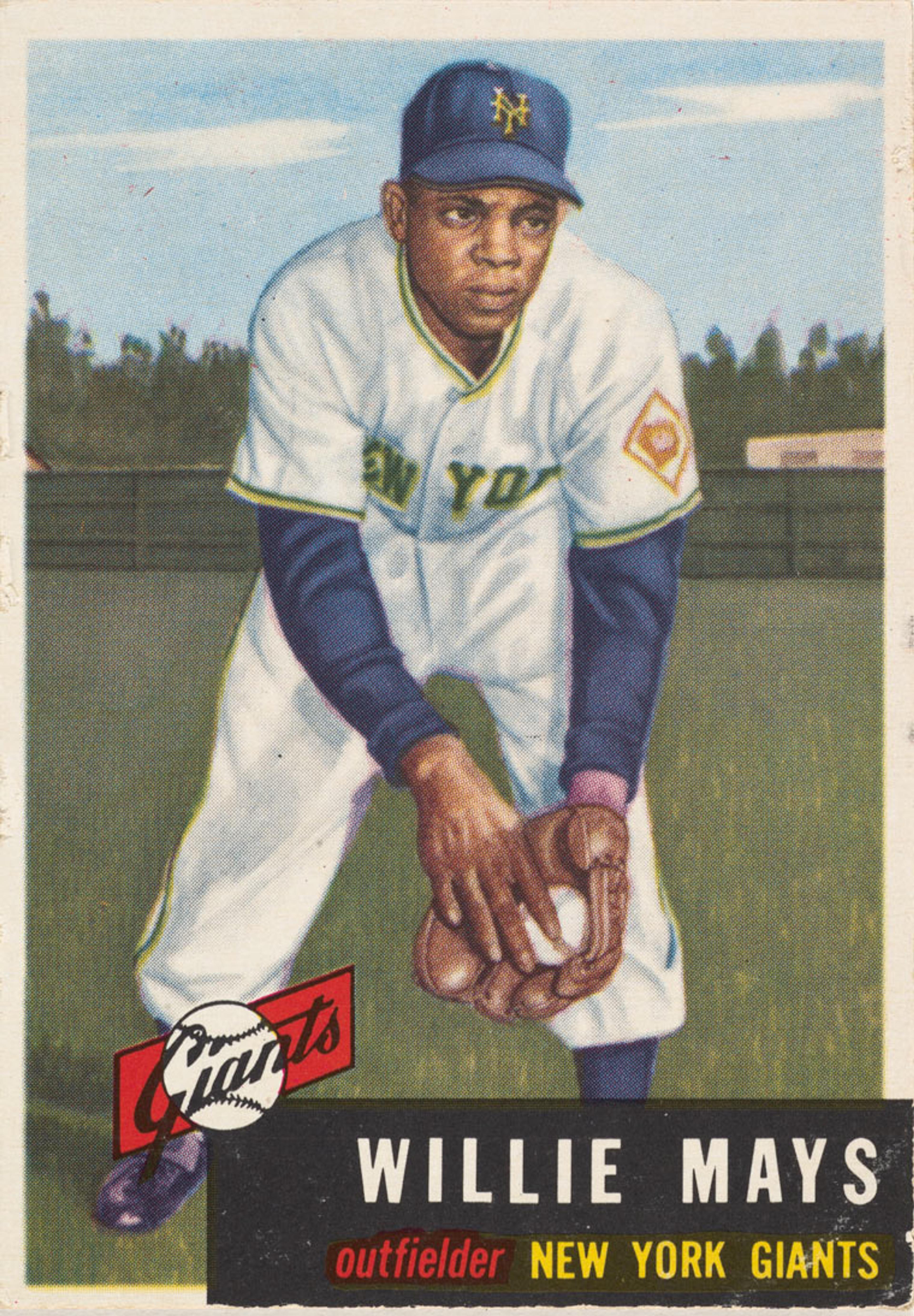
Issued by Topps Chewing Gum Company (American, Brooklyn). Card number 244, Willie Mays, Outfielder, New York Giants, from the series Topps Dugout Quiz (R414-7), issued by Topps Chewing Gum Company, 1953. Commercial color lithograph; Sheet: 3 3/4 x 2 5/8 in. (9.5 x 6.7 cm). The Metropolitan Museum of Art, New York, The Jefferson R. Burdick Collection, Gift of Jefferson R. Burdick (Burdick 328, R414-7.244)
Burdick’s collection also includes Joe DiMaggio, Willie Mays, and Stan Musial, as well as Babe Ruth, Lou Gehrig, Cy Young, Ty Cobb, and Hank Greenberg, among thousands of other cards. An avid collector, Burdick’s albums are exceptional in that they contain full sets such as the famous Bowman Gum series of 1951, which includes Mickey Mantle’s rookie card, and Topps’s 1953 set highlighting New York Yankees Philip Rizzuto, Yogi Berra, Mantle, and Brooklyn Dodgers Jackie Robinson, Duke Snider, Pee Wee Reese, and Roy Campanella. Burdick compiled the original albums that these cards are kept in by incorporating the baseball cards alongside other contemporary advertising material.
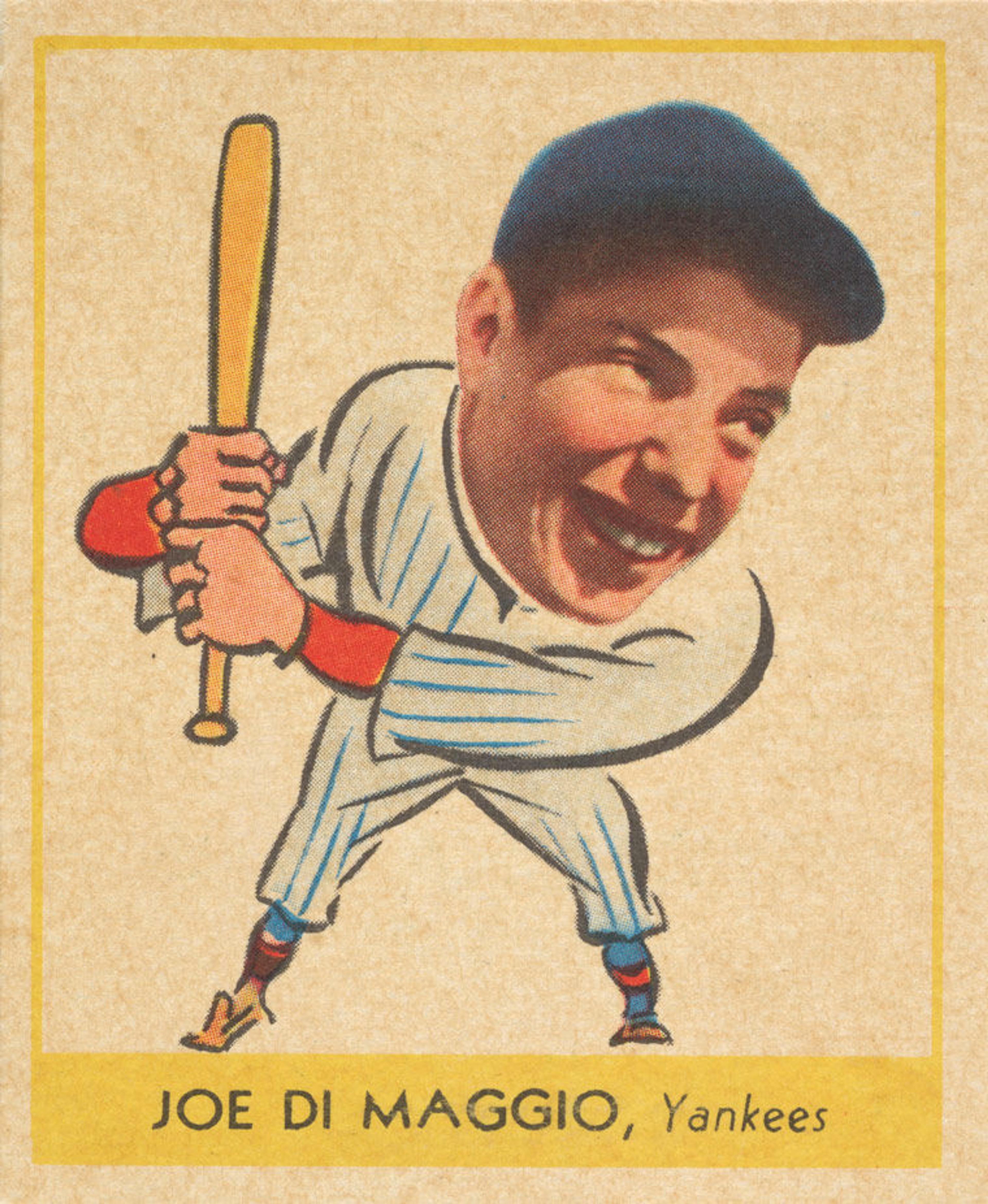
Issued by the Goudey Gum Company. Joe DiMaggio, New York Yankees, from the Heads-Up series (R323), issued by the Goudey Gum Company, 1938. Commercial color lithograph; Sheet: 2 7/8 x 2 3/8 in. (7.3 x 6 cm). The Metropolitan Museum of Art, New York, The Jefferson R. Burdick Collection, Gift of Jefferson R. Burdick (Burdick 325, R323.10)
The baseball cards document the sport through varied types of media—from lithography to photography—with imagery illustrating legends as well as the lesser-known players, owners, and teams that have contributed to the history of the game.
Famous faces
Jefferson Burdick’s philosophy for acquiring printed matter was not restricted to one particular theme, but rather aimed to “collect general, as far as possible, as a wide interest means a wider circle of friends and the increased enjoyment of obtaining new items more frequently.” While the sport cards have emerged as the most popular and widely seen portion of the material, they are by no means the only extensive grouping. Another dominant focus of Burdick’s cards, and in advertising material and souvenir cards during the late nineteenth and early twentieth centuries, is the category of actors and actresses. Meticulously collected and catalogued by Burdick, these stage-and-screen celebrity cards document the progression of printed media, ranging from early albumen photographs to vibrantly colored lithographs.
In the latter half of the nineteenth century, photography emerged as a new medium and was widely used for portraits in advertising. In combination with advanced printing techniques, this led to a faster and more economical means to distribute images, thus bolstering the promotion of businesses and their products through trade cards. Early series of actors and actresses were commonly issued in packages of tobacco goods such as the 1887 Allen & Ginter issue for Little Beauties Cigarettes, which showed theatrical poses of famous stage figures including Minnie Palmer and Edwin Booth. In addition to being a vital advertising tool, the majority of the early celebrity cards were made in the style of the popular carte-de-visite—studio portraits intended to be collected and housed in albums to be displayed alongside those which held familiar images of family and friends.

Issued by Allen & Ginter (American, Richmond, Virginia). Minnie Palmer (standing beside chair), from the Actresses and Celebrities series (N60, Type 1) promoting Little Beauties Cigarettes for Allen & Ginter brand tobacco products, 1887. Albumen photograph, 2 3/8 x 1 1/2 in. (6 x 3.8 cm). The Metropolitan Museum of Art, New York, The Jefferson R. Burdick Collection, Gift of Jefferson R. Burdick (63.350.202.60.10)
At the turn of the century, lithography gained ground as the more efficient and engaging medium for producing trade cards. Through Burdick’s collection, one can chart the careers of many of the silver screen’s most notorious stars as well as learn about the lesser-known personalities that graced early films.
While these cards were still being inserted into popular products as a means to entice potential consumers, new ways of packing began to emerge. In 1933, Dixie Cup started printing head shots of movie stars such as Joan Crawford and Clark Gable on lids of individual ice cream cups for various companies. This initiative proved extremely successful and encouraged other ice cream manufacturers to adopt creative variations of the Dixie lid, as seen in color, placement, and types of celebrities.
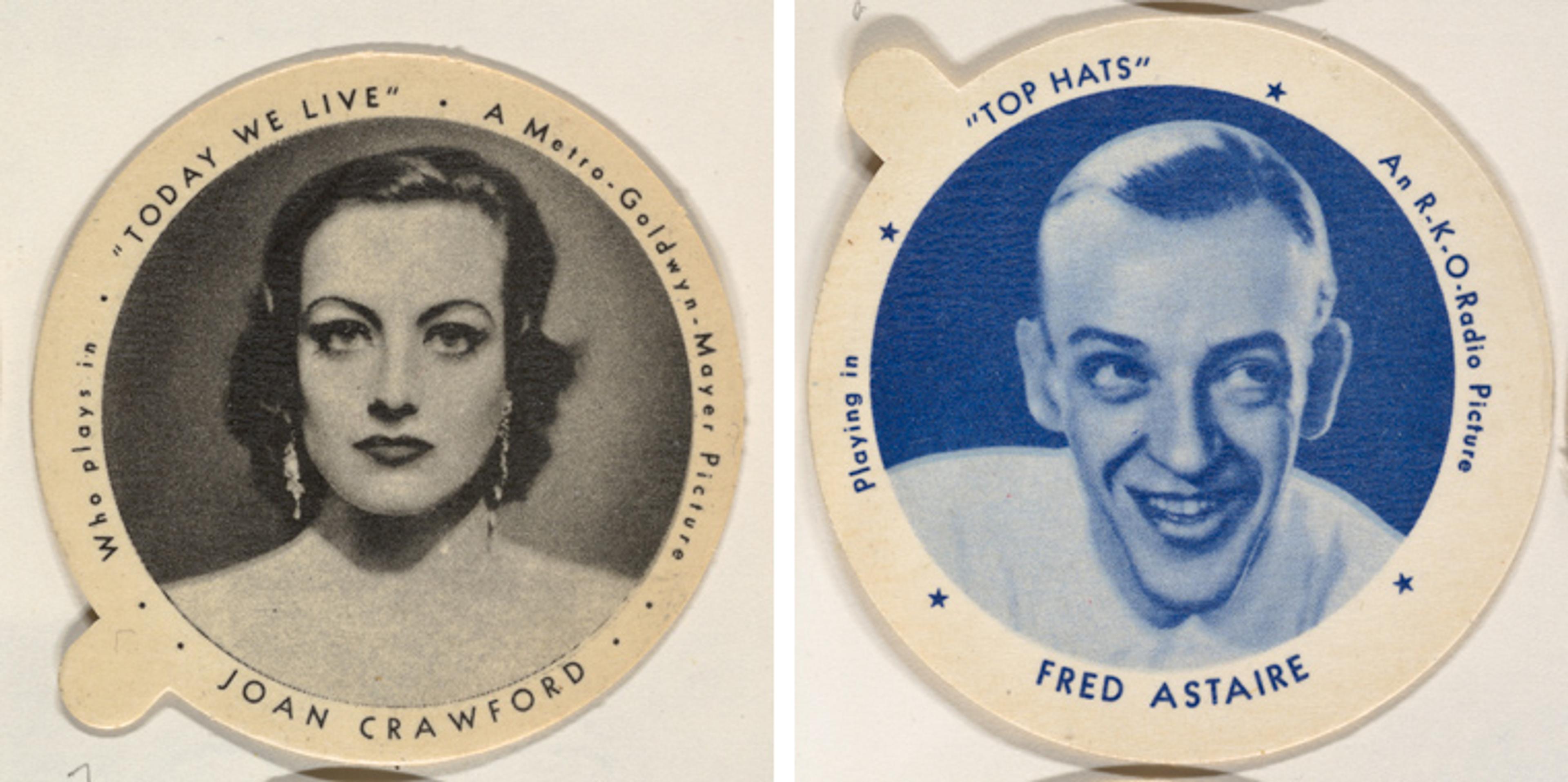
Left: Issued by Individual Drinking Cup Company, Inc. Joan Crawford, from the Movie Stars series (F3), issued by the Individual Drinking Cup Company, Inc. for Supplee Ice Cream, 1933. Commercial color lithograph, 2 3/8 x 2 3/8 in. (5.8 x 5.8 cm). The Metropolitan Museum of Art, New York (Burdick 308, F3.7). Right: Issued by Individual Drinking Cup Company, Inc. Fred Astaire, from the Movie Stars series (F3), issued by the Individual Drinking Cup Company, Inc. for Wisconsin Creameries Ice Cream, 1935. Commercial color lithograph, 2 3/8 x 2 3/8 in. (5.8 x 5.8 cm). The Metropolitan Museum of Art, New York (Burdick 308, F5.5)
Lucky Strike issued a series in the 1930s with brightly colored cartoon drawings of Douglas Fairbanks, Jr., and Jean Harlow, among others, that were printed on cards meant to be used to tally points for bridge games.
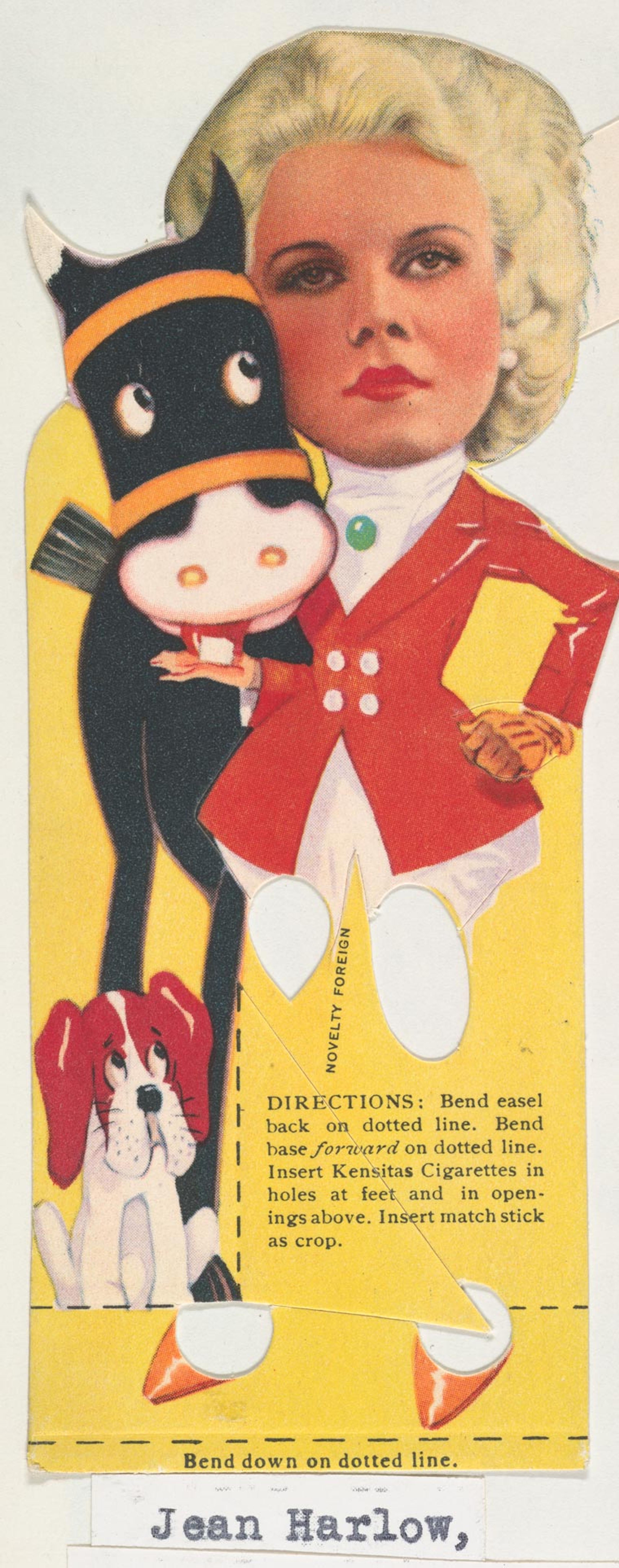
Issued by Gallaher Group. Jean Harlow, from the Place Favors series (T14), issued by the Gallaher Group for Kensitas Cigarettes, 1930s. Commercial color lithograph, 5 1/4 x 2 1/8 in. (13.4 x 5.2 cm). The Metropolitan Museum of Art, New York (Burdick 242, T14.31)
Postcards
As opposed to advertising insert cards—the dominant mode of product endorsement used by American businesses in the period after the Civil War—that were typically given away or included in goods, free of charge, postcards and greeting cards were generally purchased by consumers. These cards show the ephemeral histories of modern America and served multiple purposes: they were utilitarian objects meant to be used, but they were also frequently collected because of their subject matter, design, or historical interest.
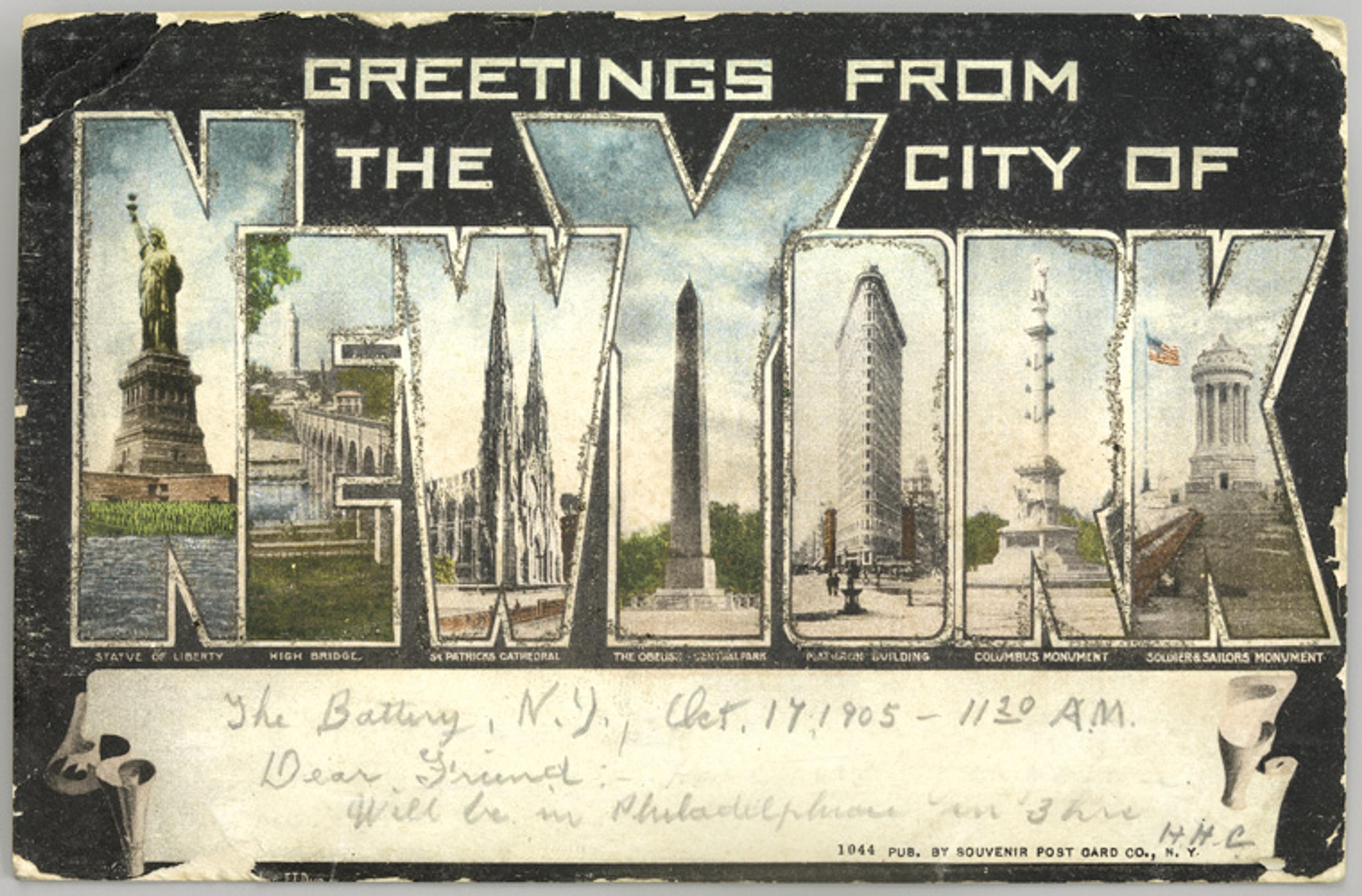
Souvenir Post Card Company. Greetings from the City of New York Postcard, ca. 1905. Commercial color lithograph with applied glitter, 3 1/2 x 5 1/4 in. (8.9 x 13.1 cm). The Metropolitan Museum of Art, New York, The Jefferson R. Burdick Collection, Gift of Jefferson R. Burdick (Burdick 405, PC70.54)
Initiated by companies as advertisements in the 1860s, within a decade the nature of postcards began to change as they increasingly became a suitable and intimate form of correspondence between friends. Due to printing and postal regulations that effected print runs and circulation, postcards were not instantly popular. In 1898, Congress passed the Private Mailing Card Act, which for the first time allowed independent companies to publish postcards. This deregulation enabled the widespread production of postcards and increased their use as simple and quick channels of communication and visual engagement. By the end of the nineteenth century, these often decorative cards were highly esteemed and avidly collected.
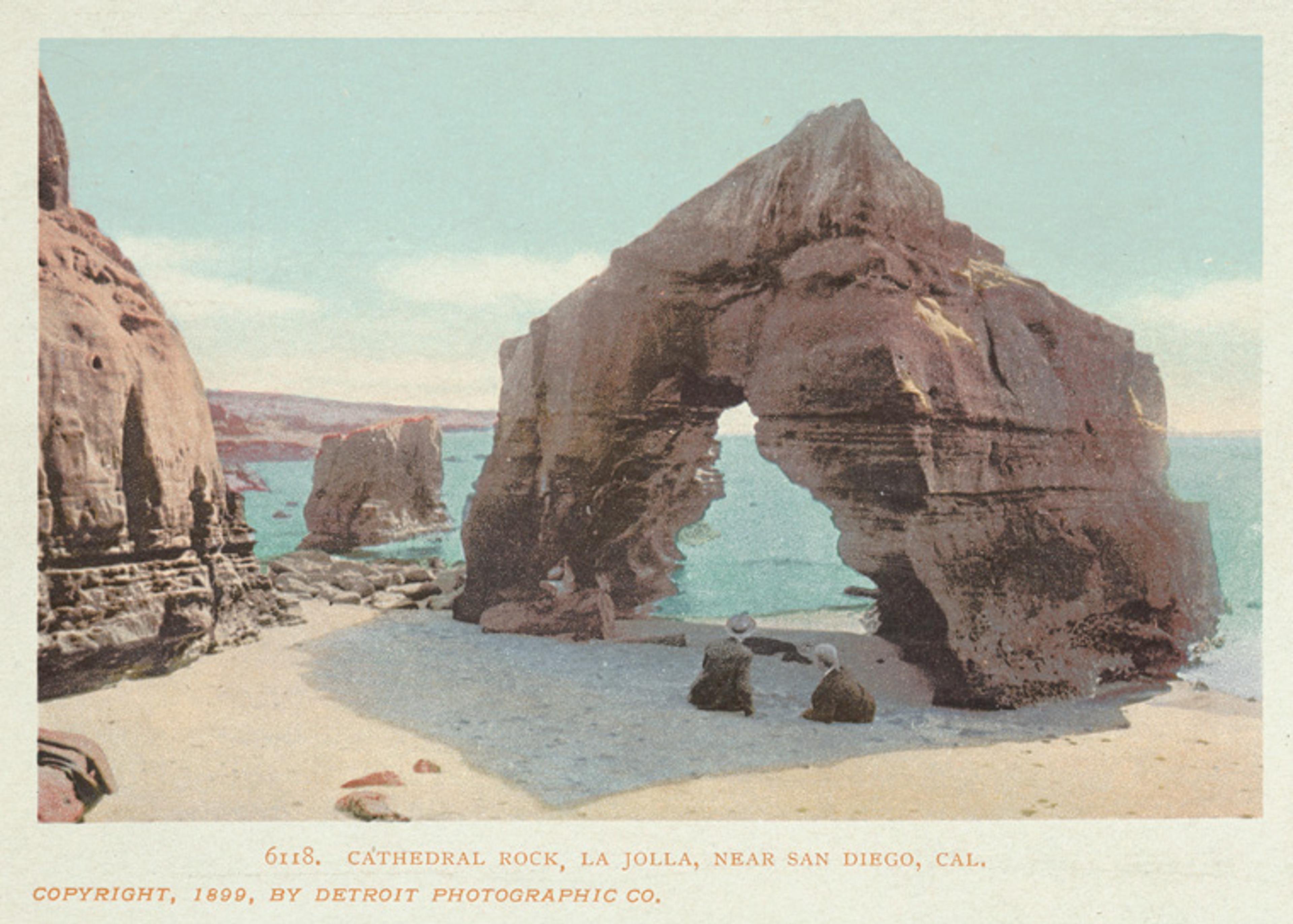
Detroit Publishing Company (American). Cathedral Rock, La Jolla, Near San Diego, California, No. 6118, 1899. Commercial color lithograph, 3 1/4 x 5 1/2 in. (8.3 x 13.8 cm). The Metropolitan Museum of Art, New York, The Jefferson R. Burdick Collection, Gift of Jefferson R. Burdick (Burdick 428, PC143.163)
Burdick catalogued the postcards in his collection according to common thematic classifications such as: viewcards, greetings, comics, expositions and events, art, novelties, and pure advertisements. Burdick’s collection, which was housed in seventy-four albums and ranges in date from 1873 to 1940, features popular public interests and notable publishing companies, and documents the rapid advancements in printing technologies. The Detroit Publishing Company is perhaps the most comprehensively represented, with twenty-three albums dedicated to their work in addition to several boxes of unnumbered cards.
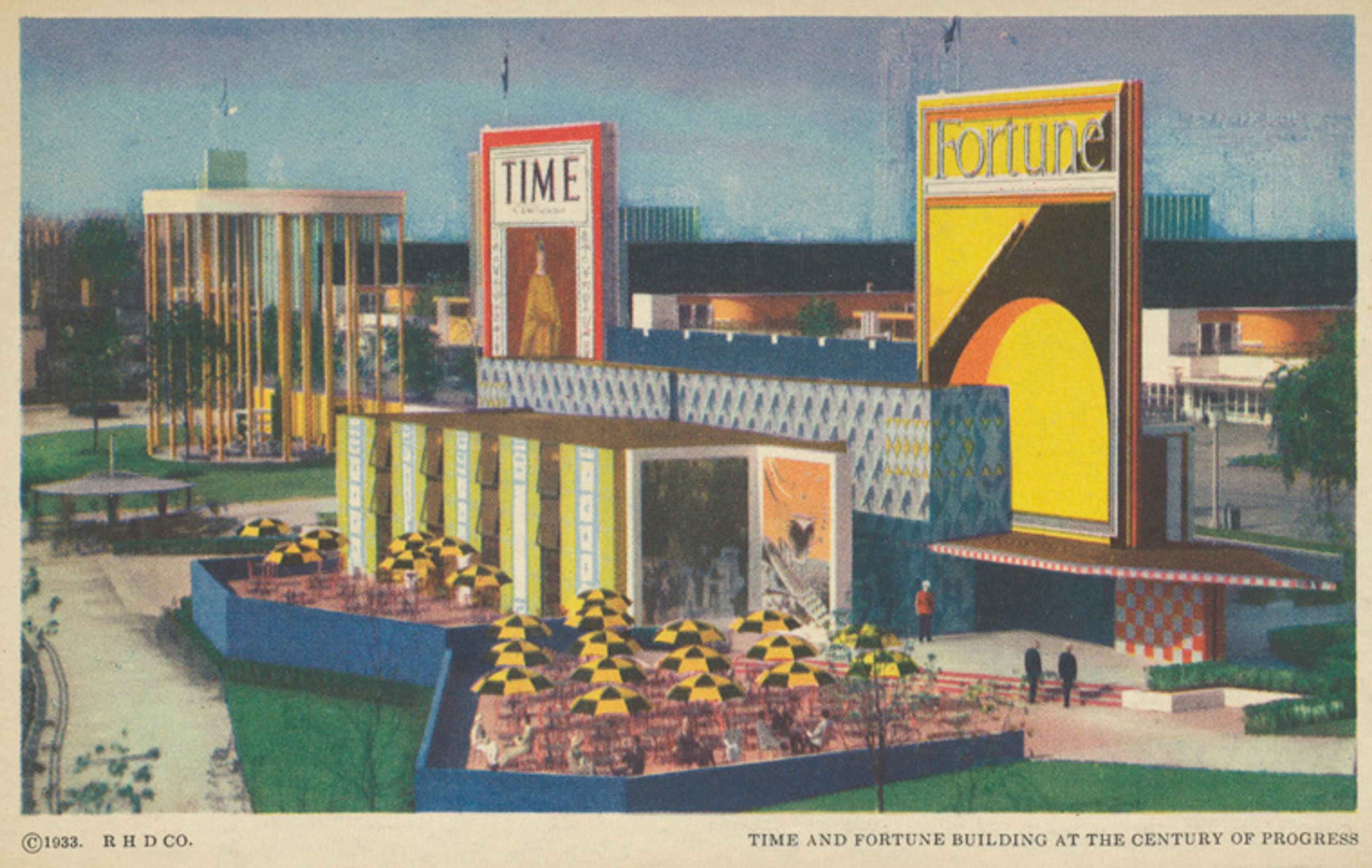
Reuben H. Donnelley Corporation, Chicago. Time and Fortune Building at the Century of Progress, from the Chicago World's Fair series (PC225-1), 1933. Commercial color lithograph, 3 5/8 x 5 1/2 in. (9 x 14 cm). The Metropolitan Museum of Art, New York, The Jefferson R. Burdick Collection, Gift of Jefferson R. Burdick (Burdick 435, PC225-1.1)
The sizable and incredibly diverse exhibitions known as World’s Fairs or Expositions, which were platforms for multicultural exchange and the sharing of ideas about science and technology (and later culture), form a large grouping in Burdick’s collection. A beautifully colored series of lithographs illustrates the important locations and buildings erected for the Century of Progress International Exposition held in Chicago in 1933. Rather than focus on Chicago’s past, as the exposition had originally intended, these cards demonstrate the new feeling of hope for a bright future in America, even in the midst of the Great Depression.

Gemloid Corporation. Night Display Central Mall Fireworks, from the New York World's Fair series (PC225-6), 1939. Commercial color lithograph, 3 1/2 x 5 1/2 in. (8.7 x 14 cm). The Metropolitan Museum of Art, New York, The Jefferson R. Burdick Collection, Gift of Jefferson R. Burdick (Burdick 435, PC225-6.5)
In addition to an abundance of viewcards devoted to the development of the city of New York, its buildings, and neighborhoods, Burdick’s collection also includes a series of cards from the 1939 World’s Fair that demonstrate the innovative printing technique of printing in color with a metallic finish, called Metalite, a patented technology developed by the Gemloid Corporation.
Sports cards
Burdick’s immense collection, numbering over three hundred thousand objects, includes all types of sports cards ranging from football, boxing, basketball, baseball, and swimming, to equestrian sports and sailing.

Issued by P.H. Mayo & Brother, Richmond, Virginia (American). John Dunlop, Harvard University, from the College Football Stars series (N302) for Mayo's Cut Plug Tobacco, 1894. Commercial lithograph, 2 7/8 x 1 5/8 in. (7.2 x 4.2 cm). The Metropolitan Museum of Art, New York, The Jefferson R. Burdick Collection, Gift of Jefferson R. Burdick (63.350.222.302.33)
The collection facilitates the telling of myriad histories about American sports, life, and culture. With an extensive collection of football cards, the rise of the sport and its dominance in printed media toward the middle of the twentieth century can be demonstrated in a unique way. The earliest series of football cards in Burdick’s collection dates from 1894 and highlights players from the Ivy League’s Yale, Harvard, and Princeton. Also present are the Leaf Gum and Bowman sets from 1948, which were the first cards produced after World War II and ushered in the modern era of football cards. The latest set collected by Burdick, while he was in the prints department of the Museum organizing and cataloguing his collection into their signature green albums, is Bazooka’s first football issue from 1959, which includes Johnny Unitas and Ollie Matson.
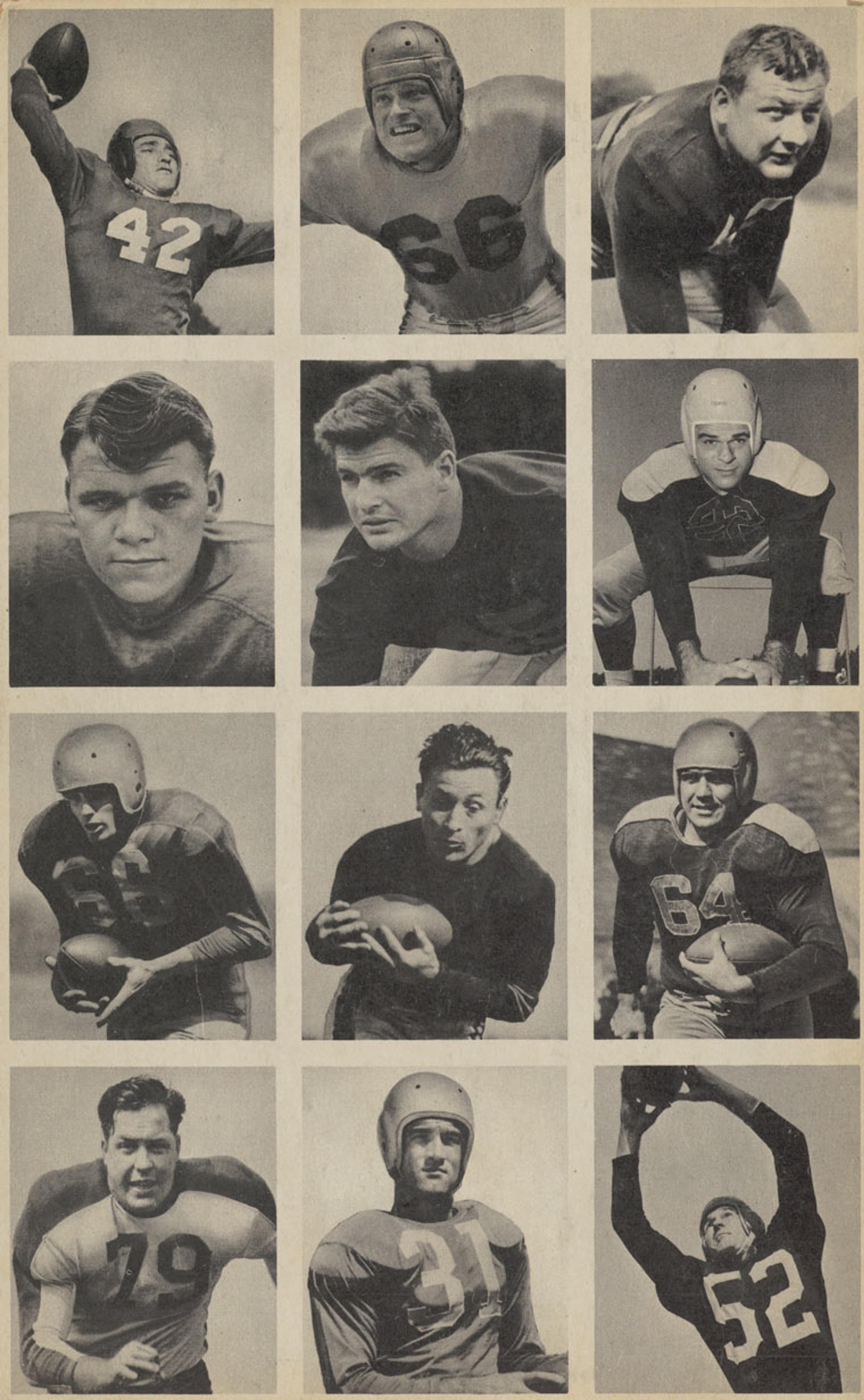
Issued by Bowman Gum Company. Sheet of 12 uncut football cards, from the Bowman Football series (R407-1) issued by Bowman Gum, 1948. Commercial color lithograph, 10 in. x 6 1/4 in. (25.4 x 15.8 cm). The Metropolitan Museum of Art, New York, The Jefferson R. Burdick Collection, Gift of Jefferson R. Burdick (Burdick 327, R407-1.1)
Other stories about America can be told through the Burdick’s sports cards, such as the ebb and flow in popularity of sports such as boxing—which dominated the collective consciousness at its height in the first decades of the twentieth century—or the role of women in sports and society at the turn of the century. “Sporting girls,” as they were often called in the late nineteenth and early twentieth centuries, emerged as a viable and even a lucrative category, despite being less frequently represented than actresses.
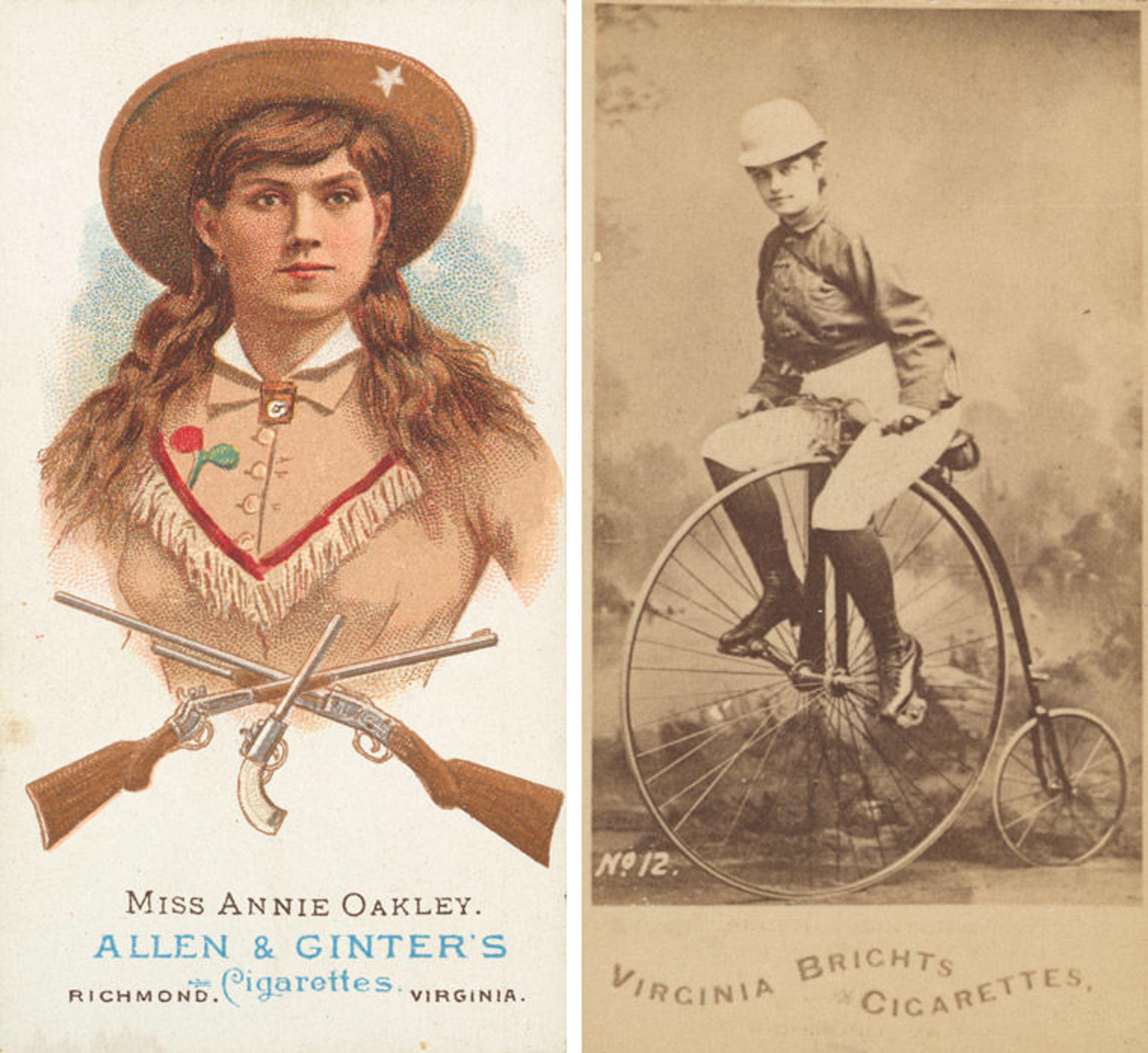
Left: Allen & Ginter (American, Richmond, Virginia). Miss Annie Oakley, Rifle Shooter, from World's Champions, Series 1 (N28) for Allen & Ginter Cigarettes, 1887. Commercial color lithograph, 2 3/4 x 1 1/2 in. (7 x 3.8 cm). The Metropolitan Museum of Art, New York, The Jefferson R. Burdick Collection, Gift of Jefferson R. Burdick (63.350.201.28.41). Right: Issued by Allen & Ginter (American, Richmond, Virginia). Card 12, from the Girl Cyclists series (N49) for Virginia Brights Cigarettes, 1887. Albumen photograph, 2 3/4 x 1 3/8 in. (7 x 3.5 cm). The Metropolitan Museum of Art, New York, The Jefferson R. Burdick Collection, Gift of Jefferson R. Burdick (63.350.203.49.5)
In 1887, the tobacco company Allen & Ginter produced a series of cards known as World’s Champions that included the sharpshooter Annie Oakley. It followed quickly with female baseball players and cyclists, and other companies such as W. Duke and Sons, Liggett & Myers, and Pan Handle Scrap produced swimmers, gymnasts, and a series that offered “a sport for every girl.” In these early days of female athleticism, the figures shown on these cards remained types rather than individuals, engaged in exercises and training but without the recognition given to their male counterparts in competitive and professional leagues.
